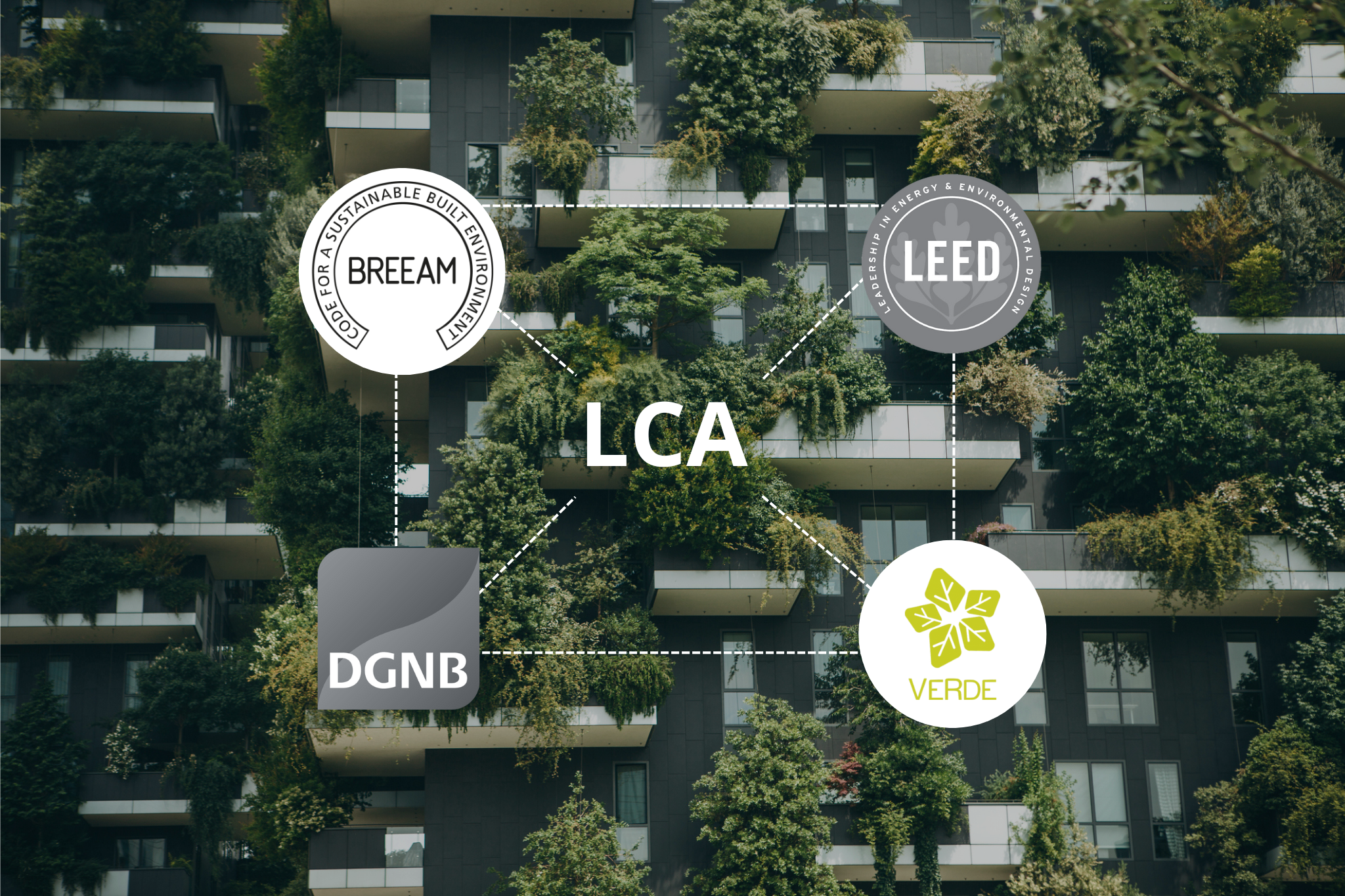Life Cycle Analysis (LCA) is a key tool in assessing the environmental impact of any product, process, or, in this case, building throughout its life cycle. This analysis allows us to study and measure the impacts associated with each phase, from raw material extraction to final disposal or recycling, providing a comprehensive view of the environmental cost of a project.
In the context of sustainable building certifications,LCA plays a crucial role, although its focus varies among them. Each certification values LCA but integrates it differently within their methodologies and guidelines. Below, we will conduct a detailed analysis of how this topic is addressed in each of these certifications and the value it brings in optimizing the environmental impact of buildings.
The value of LCA in sustainable certifications
Life Cycle Analysis is the most objective tool for measuring the environmental impacts of a building, as it allows us to identify areas where significant improvements can be made during the design, construction, operation, and decommissioning phases of the building. Its importance lies in providing precise and comparable metrics, aiding in data-driven decision-making.
In leading sustainable certifications such as BREEAM, LEED, VERDE, and DGNB, conducting an LCA is not mandatory; however, it is an optional credit that can earn additional points based on the results obtained.
To establish comparisons among the different certifications, the following guidelines have been considered:
- BREEAM ES Housing 2020 and BREEAM ES New Construction 2015
- LEED v4 2013 and LEED v4.1 2022
- VERDE Buildings 2022
- DGNB System ES 2020
Comparison of certifications: Scope of LCA
One of the main differences among sustainable certifications lies in the temporal scope of the LCA, meaning how many useful years are considered in the analysis. The scope of a building's environmental impact varies depending on the parameters set by each certification.
| BREEAM | LEED | VERDE | DGNB | ||
| LIFE SPAN (years) | 60 | 60 | 50 | 50 | |
| EVALUATION METHOD | Baseline Building | ✕ | ✔(2) | ✔(3) | ✕ |
| Year*m² ratio | ✕ | ✕ | ✕ | ✔(4) | |
| Tool | ✔(1) | ✕ | ✕ | ✕ | |
(1) BREEAM assesses the robustness of the calculation tool and the categories considered in the study.
(2) LEED compares the project building with an identical baseline building in geometry, which is not defined in the guide but must be based on a traditional construction according to the project's location and building type. The thermal transmittances of the construction solutions that form part of the envelope must be equalised.
(3) VERDE compares the project building with an identical baseline building in geometry using the construction solutions indicated in the guide. The thermal transmittances of the construction solutions that form part of the envelope must be equalised.
(4) DGNB compares the project building with a baseline building defined by a ratio per square meter for emissions embedded in materials and the consumption of the baseline building according to the CTE HE for operational emissions.
Evaluated life cycle phases
Each certification also varies in the life cycle phases assessed within the LCA. These phases encompass everything from raw material extraction (product stage) to the end of the building's life (demolition, recycling, final disposal). This approach is closely tied to the principles of the circular economy, which advocate for the reuse and recycling of materials to minimize waste and maximize the value of the resources used.
Below is a table outlining all the possible phases to be evaluated within an LCA:
| BREEAM | LEED | VERDE | DGNB | |||
| PRODUCT STAGE | A1 | Raw material supply | ✔ | ✔ | ✔(1) | ✔ |
| A2 | Transport to factory | ✔ | ✔ | ✔(1) | ✔ | |
| A3 | Manufacturing | ✔ | ✔ | ✔(1) | ✔ | |
| CONSTRUCTION STAGE | A4 | Product transport | ✔ | ✔ | ✔ | ✕ |
| A5 | Installation and construction | ✔ | ✕ | ✔ | ✕ | |
| USAGE STAGE | B1 | Use | ✔ | ✔ | ✕ | ✕ |
| B2 | Maintenance | ✔ | ✔ | ✕ | ✕ | |
| B3 | Repair | ✔ | ✔ | ✕ | ✕ | |
| B4 | Replacement | ✔ | ✔ | ✔ | ✔ | |
| B5 | Refurbishment | ✔ | ✔ | ✕ | ✕ | |
| B6 | Operational energy use | ✔ | ✕ | ✕ | ✔ | |
| B7 | Operational water use | ✔ | ✕ | ✕ | ✕ | |
| END OF LIFE STAGE | C1 | De-construction and demolition | ✔ | ✔ | ✕ | ✕ |
| C2 | Transport | ✔ | ✔ | ✕ | ✕ | |
| C3 | Waste processing | ✔ | ✔ | ✔ | ✔ | |
| C4 | Disposal | ✔ | ✔ | ✔ | ✔ | |
| BENEFITS OUTSIDE THE PRODUCT LIMITS | D | Reuse | ✔ | ✕ | ✕ | ✔ |
| D | Recovery | ✔ | ✕ | ✕ | ✔ | |
| D | Recycling | ✔ | ✕ | ✕ | ✔ | |
| D | Exported energy | ✔ | ✕ | ✕ | ✔ |
(1) In VERDE, only the Product Stage is compared to the baseline building.
Types of environmental impacts assessed
The LCA enables the evaluation of various environmental impacts arising from emissions and resource consumption at different stages of the building life cycle. However, not all certifications consider the same set of impacts:
| BREEAM | LEED | VERDE | DGNB | ||
| GWP | Global Warming Potential | ✔ | ✔ | ✔(1) | ✔ |
| ADPF | Abiotic Depletion Potential for Fossil resources (ADP-fossil fuels) | ✕ | ✔ | ✔(1) | ✔(2) |
| ADPE | Abiotic Depletion Potential for Elements (ADP - elements) | ✕ | ✕ | ✕ | ✔(2) |
| AP | Acidification Potential for soil and water | ✔ | ✔ | ✔ | ✔ |
| EP | Eutrophication Potential | ✔ | ✔ | ✔ | ✔ |
| POCP | Photochemical Ozone Creation Potential | ✔ | ✔ | ✔ | ✔ |
| ODP | Ozone Depletion Potential | ✔ | ✔ | ✔ | ✔ |
| NHWD | Non-Hazardous Waste Disposed | ✔ | ✕ | ✕ | ✕ |
| PENRT | Primary Energy Non-Renewable - Total | ✕ | ✕ | ✕ | ✔ |
| PERT | Primary Energy Renewable - Total | ✕ | ✕ | ✕ | ✔ |
| PET | Primary Energy - Total | ✕ | ✕ | ✕ | ✔ |
| FW | Use of net Fresh Water | ✕ | ✕ | ✕ | ✔(2) |
(1) In VERDE, only the GWP and ADPF impacts are compared to the baseline building.
(2) In DGNB, these categories are optional.
Study categories
Another distinguishing factor among certifications is the focus on the studied building categories. Some certifications prioritize certain categories while omitting others.
| BREEAM | LEED | VERDE | DGNB | |
| Facade | ✔ | ✔ | ✔ | ✔ |
| Roof | ✔ | ✔ | ✔ | ✔ |
| Floor slabs | ✔ | ✔ | ✔ | ✔ |
| Windows | ✔ | ✔ | ✔ | ✔ |
| Exterior doors | ✔ | ✔ | ✔(1) | ✔ |
| Semi-exterior doors | ✔ | ✔ | ✔(1) | ✔ |
| Interior doors | ✔ | ✕ | ✔(1) | ✔ |
| Sills | ✔ | ✔ | ✔ | ✔ |
| Pillars | ✔ | ✔ | ✔(1) | ✔ |
| Beams | ✔ | ✔ | ✔(1) | ✔ |
| Foundation | ✔ | ✔ | ✔(1) | ✔ |
| Semi-exterior partitions | ✔ | ✔ | ✔ | ✔ |
| Interior partitions | ✔ | ✕ | ✔ | ✔ |
| Urban development | ✔ | ✕ | ✕ | ✕ |
(1) In VERDE, only the indicated categories are compared to the baseline building, primarily excluding categories related to the structure.
Conclusion: The importance of integrating LCA in sustainable design
Life Cycle Analysis is an essential tool for gaining a comprehensive understanding of a building's environmental impact throughout its entire life cycle. In the realm of sustainable certifications, LCA not only allows for earning additional points but also provides a solid foundation for informed decision-making during the design and construction phases.
Each certification approaches LCA differently, excelling in some areas while overlooking others, highlighting the necessity of tailoring the analysis to the specific priorities of the project. Integrating LCA from the early stages of planning and design is one of the most effective ways to ensure that the building not only meets sustainability standards but also minimizes its long-term environmental footprint.
LCA is not merely a technical requirement; it is a crucial tool for promoting responsible construction, minimizing ecological impact, and creating a more sustainable future for our cities and communities.


